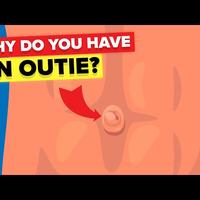Outie Belly Button - Why Do Some People Have It?
It's one of the very few things that all human beings have in common - we all have one,
even if they might look a little bit different. Of course, we're talking
about belly buttons. Innie or outie belly buttons - why do some people have them?
Why do humans even have belly buttons in the first place? Believe it or not, the answer goes back
to before we were even born. As a human fetus is growing inside its mother's uterus, it can't eat,
drink or breath on it's own - you know, all those things that keep us alive. To survive,
the baby needs to get all of these things directly from the mother. The baby is connected to the
mother's placenta by the umbilical cord, and all of the nutrients and oxygen that the baby needs to
survive travel from mother to baby through the umbilical cord. Once the baby is born,
though, it can finally drink milk and breath on its own, and the umbilical cord becomes
useless. That's why, shortly after birth, the doctor will clamp or cut the cord,
severing the connection between mother and baby. Within a week of birth, the little
piece of the umbilical cord that is left will dry up and fall off, and what's left behind becomes
our belly button. That means that our belly buttons are actually our very first scars.
Now we know why all humans have belly buttons - by why do some people have an innie,
while others have an outie? Just like the name implies, an innie belly button looks like a deep,
dark hole, and it is by far the more common type of belly button - about 90% of people have an
innie. An outie, on the other hand, pops outwards like a little button, and only about 10% of people
have one. Whether a person has an innie or an outie depends on how the scar tissue forms after
the umbilical cord is cut. Contrary to popular belief, the doctor who cuts the umbilical cord
has very little control over whether a baby will have an innie or an outie. Cutting the umbilical
cord longer or shorter doesn't guarantee an innie or outie belly button will form,
so unfortunately we can't request our preferred belly button type at birth.
Instead, it actually depends on how much space there is between the skin and the abdominal
wall - less skin leads to an innie, while more skin makes it more likely to have an outie.
Humans aren't the only animals with belly buttons - most mammals have them. But,
since most animals chew off the umbilical cord themselves rather than neatly cut it and let it
dry up and fall off, the resulting scar is usually much flatter and harder to see on other animals,
and it tends to look more like an “in-betweenie” than a typical innie or outie.
So, what if someone really hates their belly button? Is there anything that can be done to
reshape it? As a matter of fact, there is. An umbilicoplasty is a type of surgery that
can turn a less common outie belly button into the more common, and arguably more desirable,
innie. Anyone willing to fork over $2,000 dollars for the 45 minute procedure can finally
have the belly button of their dreams. While the procedure is usually done for cosmetic reasons,
it might also be required to repair an umbilical hernia, a rare complication
where part of the intestine pokes through the umbilical opening in the abdominal wall.
So, do our belly buttons actually do anything? Besides collecting lint and bacteria,
the answer is no. Belly buttons are simply a useless scar, but a 2012 study did find that
there are more than 2,300 different types of bacteria in the human belly button,
so that's something, we guess… And speaking of lint, have you ever wondered why your
belly button seems to collect so much of it? It's actually because of a special type of hair that
grows in our belly buttons. We can thank these fluffy hairs, which have tiny barbs on them,
for getting stuck to our clothing and leaving us with a dryer's worth of belly button lint.
Thanks to their prime location at the very center of our bodies,
the belly button has held a special place in many cultures throughout history,
but it wouldn't do to be caught spending too much time admiring one. The term navel-gazer is
reserved for a self-centered person who spends too much time looking at themselves. For someone with
omphalophobia, though, it likely wouldn't matter whether they have an innie or an outie - thanks
to their fear of belly buttons, they probably wouldn't spend much time naval-gazing, anyways!
If you thought this video was interesting, be sure and check out our other videos,
like this video called “This Is Why You're Fat”. Or, perhaps you'll like this other video instead.
As always, thanks for watching, and don't forget to like, share and subscribe!
See you next time!

